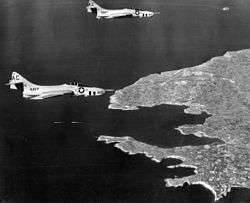VFP-62
Light Photographic Squadron 62 (VFP-62) was an aviation unit of the United States Navy in service from 1949 to 1968. The squadron provided a detachment of reconnaissance planes for each of the Carrier Air Wings of the U.S. Atlantic Fleet.
| Light Photographic Squadron 62 | |
|---|---|
VFP-62 Insignia | |
| Active | January 1949 - 1 January 1968 |
| Country | United States |
| Branch | United States Navy |
| Role | Aerial reconnaissance |
| Part of | Inactive |
| Nickname(s) | Fighting Photos |
| Engagements | Korean War Cuban Missile Crisis Vietnam War |
| Aircraft flown | |
| Fighter | F8F-2P Bearcat F4U-5P Corsair F2H-2P Banshee F9F-6P/-8P Cougar RF-8A/G Crusader |
History
VFP-62 was established in January 1949 as Composite Squadron SIX TWO (VC-62), nicknamed the Fighting Photos, and was equipped with Grumman F8F-2P Bearcat and Vought F4U-5P Corsair fighter aircraft converted to reconnaissance platforms. The first VC-62 detachment was assigned to Carrier Air Group 7 (CVG-7) aboard the aircraft carrier USS Leyte (CV-32) from September 1949 to January 1950 for a deployment to the Mediterranean Sea.
Detachments of the squadron operated from all Atlantic Fleet attack aircraft carriers based on the U.S. east coast. From September 1950 to February 1951, a VC-62 detachment also operated during the Korean War from the USS Leyte as part of CVG-3.
In 1951, the squadron converted to jet aircraft and was equipped with the McDonnell F2H-2P Banshee. On 2 July 1956, the squadron was redesignated Photographic Reconnaissance Squadron SIX TWO (VFP-62) and transitioned to the Grumman F9F-6P Cougar (later F9F-8P).
Renamed Light Photographic Squadron SIX TWO (VFP-62) in order to distinguish it from Heavy Photographic squadrons that were being established, the squadron received its first Vought F8U-1P Crusader aircraft in 1959, which were redesignated as the RF-8A Crusader in 1962. In 1966, these aircraft were upgraded to a new standard designated as the RF-8G.
VFP-62 is best known as the squadron that took the first low-level photos of the Soviet missile bases in Cuba during the Cuban Missile Crisis in October 1962. At the time, it was commanded by then-Commander William Ecker, USN. In 2000, the movie Thirteen Days (film), produced by Kevin Costner, showed the actions of Ecker and the other members of VFP-62 during the Cuban Missile Crisis.
From June 1966 to February 1967, VFP-62 Det 42 operated from the USS Franklin D. Roosevelt (CVA-42) off Vietnam as part of CVW-1. VFP-62 was subsequently disestablished on 1 January 1968, with its role assumed by its Pacific Fleet sister squadron, VFP-63, also flying the RF-8G, and by several reconnaissance attack squadrons (RVAH) flying the RA-5C Vigilante.
Gallery
%2C_in_1952.jpg) An F8F-2P over USS Midway 1949/50
An F8F-2P over USS Midway 1949/50 An F2H-2P in 1956
An F2H-2P in 1956 F9F-6Ps in 1956
F9F-6Ps in 1956 F9F-8Ps over Malta, 1958
F9F-8Ps over Malta, 1958.jpg) An A4D-2 refuels an F8U-1P in 1960
An A4D-2 refuels an F8U-1P in 1960 A VFP-62 RF-8G damaged by flak over Vietnam, 1967
A VFP-62 RF-8G damaged by flak over Vietnam, 1967
Unit awards
On November 26, 1962, VFP-62 was awarded the first peacetime Navy Unit Commendation, personally by President John F. Kennedy for the squadron's actions during the Cuban Missile Crisis.